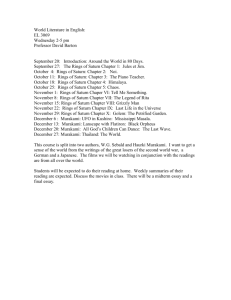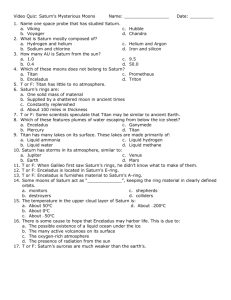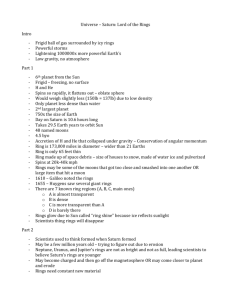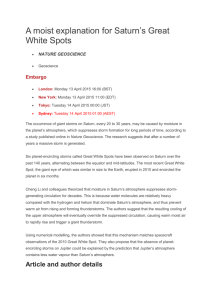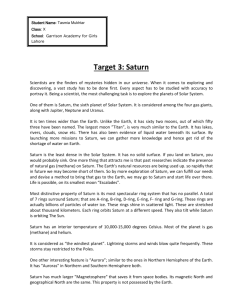Saturn
advertisement
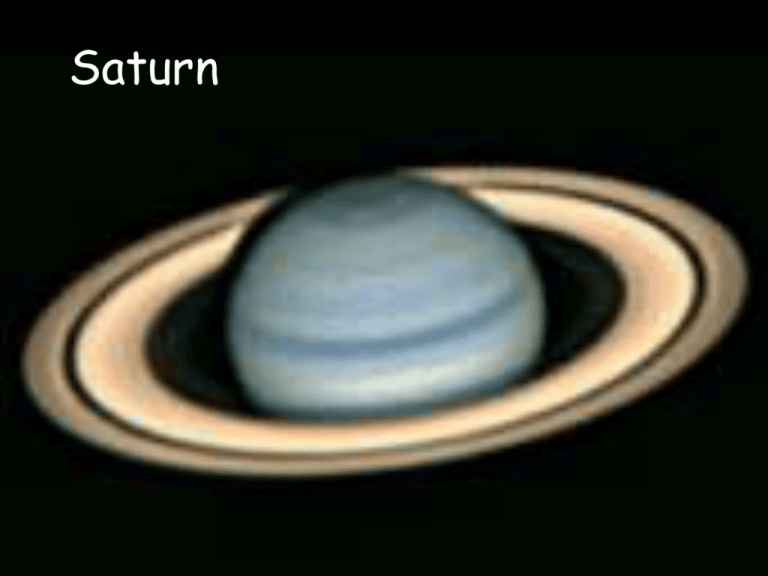
Saturn Exploration of Saturn Pioneer 11, Voyager 1 & 2 - Late 70’s, early 80’s Cassini, Summer 2004 Saturn is the second largest planet in the Solar System. Saturn emits 79% more energy than it receives from the Sun. Saturn receives 1/90th the amount of sunlight Earth receives. Saturn and Earth Compared If you placed Saturn and its main rings (excluding the diffuse Ering) between the Earth and the Moon, Saturn would barely fit. Earth-Moon distance = 384,000 km (239,000 miles) Saturn and ring system diameter =340,000 km (211,310 miles) Saturn Physical Facts Saturn is the sixth planet from the Sun, orbiting at an average distance of 9.54 astronomical units (1429.4 million kilometers or 888 million miles). Saturn receives approximately 1/90th the amount of sunlight the Earth receives. Diameter = 120,660 km (75,412 miles) -compare to Earth (12,756 km) Mass = 569x1024 kg (95 times more massive than Earth) Rotation Period = 10 hours and 40 minutes Jupiter’s Twin? Similar to Jupiter - except less mass. Less mass means less gravity Less dense (lowest density planet) Less distinct cloud features (same clouds, just not as pretty) Weaker magnetic field Less spectacular aurora Saturn’s Atmosphere Saturn’s primary atmospheric contents are: Hydrogen (94%) Helium (6%) In addition, there are traces of ammonia, methane, ethane, phosphine, acetylene, methylacetylene, and propane. What makes those colorful golden bands in Saturn’s upper atmosphere? ---Ammonia ice crystals Saturn’s Wild Winds •Saturn has the second fastest measured winds in the Solar System. Only Neptune has faster winds. •Wind speeds at similar latitudes north and south of the equator are nearly the same. •Equatorial Speeds: blow to the East at 500 meters/second (1,100 miles per hour) How fast is that? •A jet airplane travels at an average speed of 550 miles per hour. •The strongest hurricane (cyclone) winds top out at about 220 miles per hour. •A tsunami travels along the open water at 550 miles per hour. •The speed of sound is 660 miles per hour at 30,000 feet. Storms Saturn's South Pole Hurricane The eye is 2/3 the size of the Earth Saturn's North Pole Vortex Pretty Hexagon, Isn’t it? Saturn's South Pole Hurricane Magnetosphere Magnetic fields such as those of Earth and Saturn are approximated by a dipole (a simple structure with a north and south pole like a bar magnet). There is no measurable off-set between the magnetic dipole and Saturn’s rotation axes. This is unique in the Solar System. By comparison, Earth’s magnetic field is off-set from the rotation axis by 11.4° What is a magnetosphere? Saturn generates a magnetic field that shields the planet, its rings, and moons from the solar wind. This shield is called a “magnetosphere.” Aurora Saturn's Interior Rings, Rings, Rings! The first planet to have its rings detected was Saturn. Saturn’s rings were seen by Galileo in 1614 but disappeared soon afterwards. The rings appeared to have a variety of forms when first detected: The Rings Disappear! Tilt of the planet every 16 years Look for satellites! Huygens’ Explanation Christiaan Huygens was the first person to explain the rings (and their disappearance) when in 1659 he worked out that Saturn must be surrounded by a thin flat ring that does not touch the planet. The appearance and disappearance of the rings was due the different viewing geometries as seen from Earth. Maxwell’s Essay James Clerk Maxwell won the Adams Prize Essay in 1856 for his work on the stability of Saturn’s rings. He showed that the rings could not be solid but had to be composed of particles. Cassini Division B ring A ring C ring Encke Division Saturn’s Magnificent Rings Saturn’s rings are made primarily of water ice. False color images of Saturn’s rings show different colors that illustrate some of the possible variations in chemical composition. Typical ring particle sizes range from micrometers (roughly the size of cigarette smoke) to ice boulders larger than tens of meters. Saturn’s Rings The order of the rings and moons, starting with the closest to Saturn, is: Saturn D-Ring C-Ring B-Ring Cassini Division A-Ring Encke Division Pan Atlas Prometheus Pandora F-Ring Epimetheus Janus G-Ring Mimas Enceladus Tethys Telesto Calypso Dione Helene Rhea Titan Hyperion Iapetus Phoebe Others… Many more rings found - thin outer rings Shepherd Satellites Inside the Rings Artist's Conception Roche Limit Saturn’s Ring System Saturn’s Ring System Saturn’s Ring System Saturn’s Ring System Saturn’s Ring System Shepherd Moons Magnetosphere Magnetic fields such as those of Earth and Saturn are approximated by a dipole (a simple structure with a north and south pole like a bar magnet). There is no measurable off-set between the magnetic dipole and Saturn’s rotation axes. This is unique in the Solar System. By comparison, Earth’s magnetic field is off-set from the rotation axis by 11.4° What is a magnetosphere? Saturn generates a magnetic field that shields the planet, its rings, and moons from the solar wind. This shield is called a “magnetosphere.” Aurora Saturn's Interior The first planet to have its rings detected was Saturn. Saturn’s rings were seen by Galileo in 1614 but disappeared soon afterwards. The rings appeared to have a variety of forms when first detected: The Rings Disappear! Tilt of the planet every 16 years Look for satellites! Huygens’ Explanation Christiaan Huygens was the first person to explain the rings (and their disappearance) when in 1659 he worked out that Saturn must be surrounded by a thin flat ring that does not touch the planet. The appearance and disappearance of the rings was due the different viewing geometries as seen from Earth. Maxwell’s Essay James Clerk Maxwell won the Adams Prize Essay in 1856 for his work on the stability of Saturn’s rings. He showed that the rings could not be solid but had to be composed of particles. Roche Limit Saturn’s Satellites About 30 known so far Most are small, icy, cratered worlds 1 very large one - Titan Titan - The “Earthlike” Moon? It has an atmosphere! 1.6 x Earth’s pressure Mainly Nitrogen Some methane, ethane Very cold 100 K (-290 F) Titan Titan has a thick atmosphere that is primarily composed of Nitrogen. Nitrogen ~ 95% Methane ~ 5% traces of hydrocarbons and hydrogen cyanide Distance from Saturn = 1,222,000 km (759,478 miles) Orbital Period = 15.94 days Diameter = 5150 km (3200 miles) 40% the diameter of Earth Surface Temperature = 95° Kelvin (-178° C, -288° F) Titan and Earth While Titan is only 40% the diameter as Earth, its atmosphere extends 10 times higher into space than Earth’s atmosphere. Titan’s atmosphere is composed primarily of nitrogen (90-97%) and methane (2-10%). Earth’s atmosphere is composed primarily of nitrogen (78%) and oxygen (21%). Of course the surface temperature on Titan is a chilling 95°K (-178°C or -288°F) compared to Earth’s balmy 290°K (17°C or 63°F) Huygens Descent to Titan Descent As the probe enters Titan’s atmosphere and slows, a small parachute is released which deploys the main probe parachute. Once the parachute is fully open, the decelerator shield is jettisoned and the probe drifts toward Titan’s surface. About 40 kilometers (24.86 miles) above the surface the main chute is jettisoned and a smaller drogue chute carries the probe the remaining distance. Descent time = 2.5 hours Impact Speed = 15 miles per hour or 7 m/sec (comparable to a skydiver landing with an open parachute) Surface collection time = 30 minutes The Cassini spacecraft’s probe landed to investigate the surface and atmosphere of Titan Huygen’s Landing Site ‘x’ marks the spot Titan’s Shoreline Lakefront Property? Clear shorelines that are reminiscent of terrestrial lakes. With Titan's colder temperatures and hydrocarbon-rich atmosphere, however, the lakes likely contain a combination of methane and ethane, not water. This lake is roughly 20 kilometers by 25 kilometers (12 to 16 miles) across. It features several narrow or angular bays, including a broad peninsula that on Earth would be evidence that the surrounding terrain is higher and confines the liquid. Broader bays, such as the one seen at right, might result when the terrain is gentler, as for example on a beach. Ice Volcano on Titan Titan’s Surface Icy Satellites The term “icy satellites” serves to separate Titan from the other, smaller moons. Before 2000, Saturn had 17 “icy satellites”. Today there are 29 recognized “icy satellites” of Saturn. The original 17 are named after figures in Greek and Roman mythology. The 12 new additions carry temporary names. 16 of Saturn’s satellites rotate synchronously (they always show the same face toward Saturn just like Earth’s Moon does). Icy Satellites Iapetus - with one hemisphere extremely reflective and the other as dark as black velvet, this satellite has a split personality. Enceladus is very bright and may re-supply the E-ring with materials through water eruptions. Mimas has an enormous crater on one side hat nearly split the satellite apart. More Unique Satellites Hyperion has an odd shape (like a hamburger patty) and rotates chaotically due to the gravitational influence of Titan. Tiny Pan orbits within Saturn’s A-ring and helps clear the Encke Gap of material. Phoebe does her own thing taking 550 days to orbit the planet. And that orbit is retrograde meaning she travels backward to her neighbors. Lagrangian Satellites Lagrangian satellites are pairs of moons that share an orbit. A small satellite orbits in the Langrangian point of a larger satellite. Lagrangian points are locations within an object’s orbit where a less massive body can move in an identical, stable orbit. Lagrangian points lie 60° ahead or behind the larger satellite. Which are the Lagrangian Satellites of Saturn? Helene is the Lagrangian satellite of Dione Calypso and Telesto are Lagrangian satellites of Tethys. Tethys Shepherd Satellites Shepherd Satellites help constrain the ring material, helping define the edges of the rings they orbit with. Atlas lies several hundred kilometers from the outer edge of the A-ring. Prometheus and Pandora orbit on opposite sides of Saturn’s F-ring. Co-orbital Satellites Janus and Epimetheus move in almost identical orbits at about two and one-half Saturn radii. This is 151,000 kilometers (94,375 miles). They are called “co-orbital” satellites because of this. Janus Epimetheus Because Epimetheus orbits slightly faster than Janus, Epimetheus overtakes Janus in their orbit once every four years.



